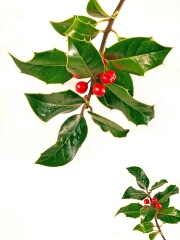The origin of Santa Claus begins about 300 years after the birth of Jesus with Saint Nicholas, Bishop of Myra, an area in present day Turkey. By all accounts St. Nicholas was a generous man who loved Jesus and was particularly devoted to children. After his death around 340 A.D. he was buried in Myra, but in 1087 Italian sailors purportedly stole his remains and removed them to Bari, Italy, greatly increasing St. Nicholas’ popularity throughout Europe.
His kindness and reputation for generosity gave rise to claims that he could perform miracles thus increasing devotion to him. St. Nicholas became the patron saint of Russia, where he was known by his red cape, flowing white beard, and bishop’s mitre. In Greece, he is the patron saint of sailors; in France he was the patron of lawyers; and in Belgium the patron of children and travellers. Thousands of churches across Europe were dedicated to him and some time around the 12th century an official church holiday was created in his honor. The Feast of St. Nicholas was celebrated December 6 and the day was marked by gift-giving and charity.
After the Reformation, European followers of St. Nicholas dwindled, but the legend was kept alive in Holland where the Dutch spelling of his name Sint Nikolaas was eventually transformed to Sinterklaas. Dutch children would leave their wooden shoes by the fireplace, and Sinterklaas would reward good children by placing treats in their shoes. Dutch colonists brought this tradition with them to America in the 17th century and here the Anglican name of Santa Claus emerged.
In 1822 Clement C. Moore composed the poem A Visit From Saint Nicholas, published as The Night Before Christmas as a gift for his children. In it, he portrayed Santa Claus with “…a broad face and a little round belly, that shook when he laughed, like a bowl full of jelly. He was chubby and plump, a right jolly old elf…” Other countries feature different gift-bearers for the Christmas or Advent season: La Befana in Italy, Christkindl or the Christ Child in Switzerland and Austria, and Father Christmas in England. In France, the gift giver is known as Pere Noël, Father Christmas or the Christ Child. In Spain, Puerto Rico, and Mexico The Three Kings supposedly bring gifts at Christmas. Still, the figure of Santa Claus as a jolly, benevolent, plump man in a red suit described in Moore’s poem remains with us today and is recognized by children and adults alike around the world.
So how do we transform this to make it a reminder of the birth of Jesus Christ?
When you think of Santa Claus, remember that he was a real person who heard about Jesus, decided to follow Him, then secretly and unselfishly poured out love on people around him. Because he loved Jesus so much and did so many kind deeds, he was called a ’saint’, meaning “one who is separated for a special task”. We too have been made ’saints’, but not by anything that we have done. We are made saints, “separated for a special task”, when we embrace Jesus as our Savior. Nicholas gave because Jesus first gave His life for us. Santa should remind us to unselfishly give the gift of love to others and to God, not just at Jesus’ birthday, but throughout the year.
A great children’s book about this is Santa, Are You For Real? by Harold Myra.




